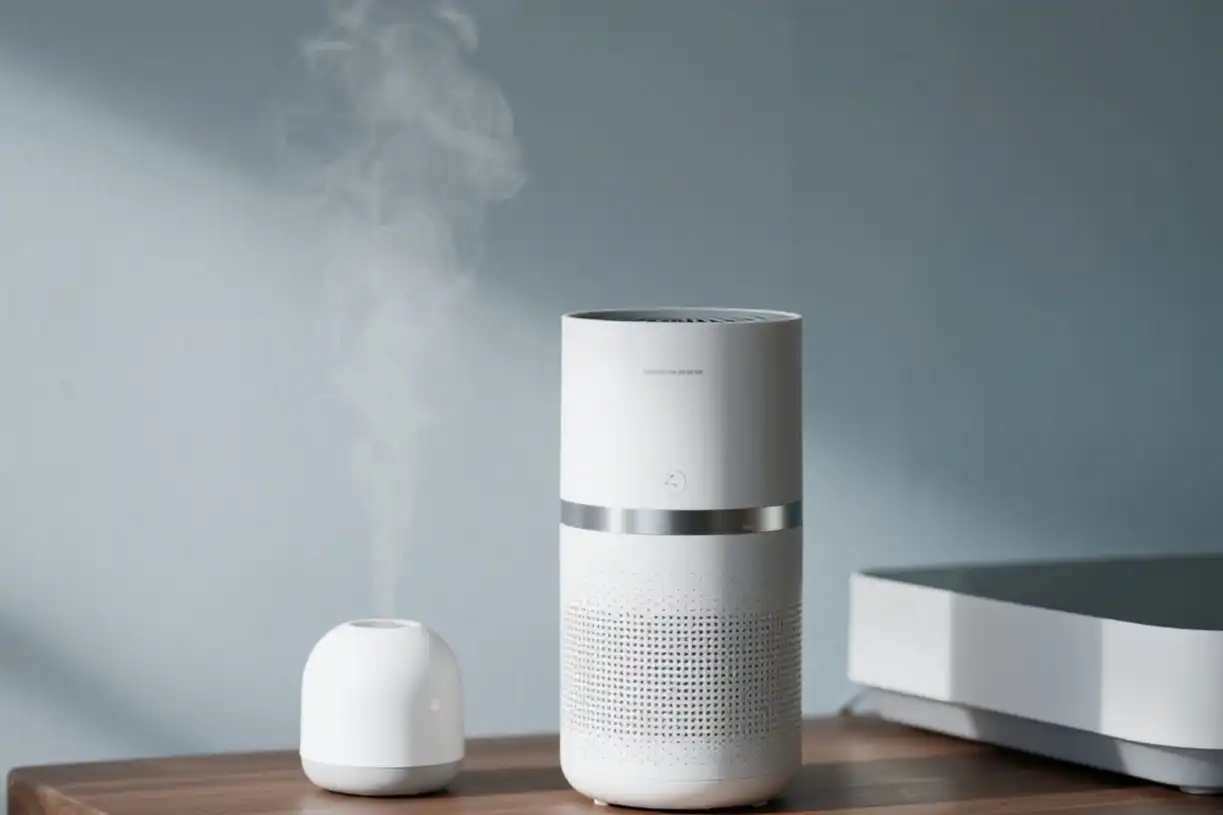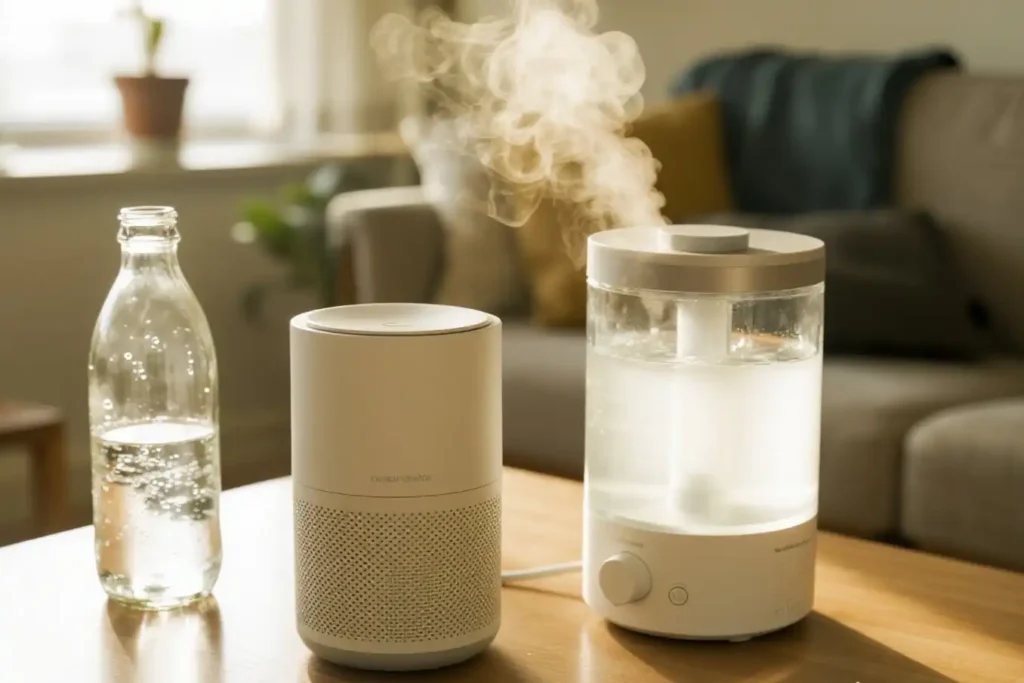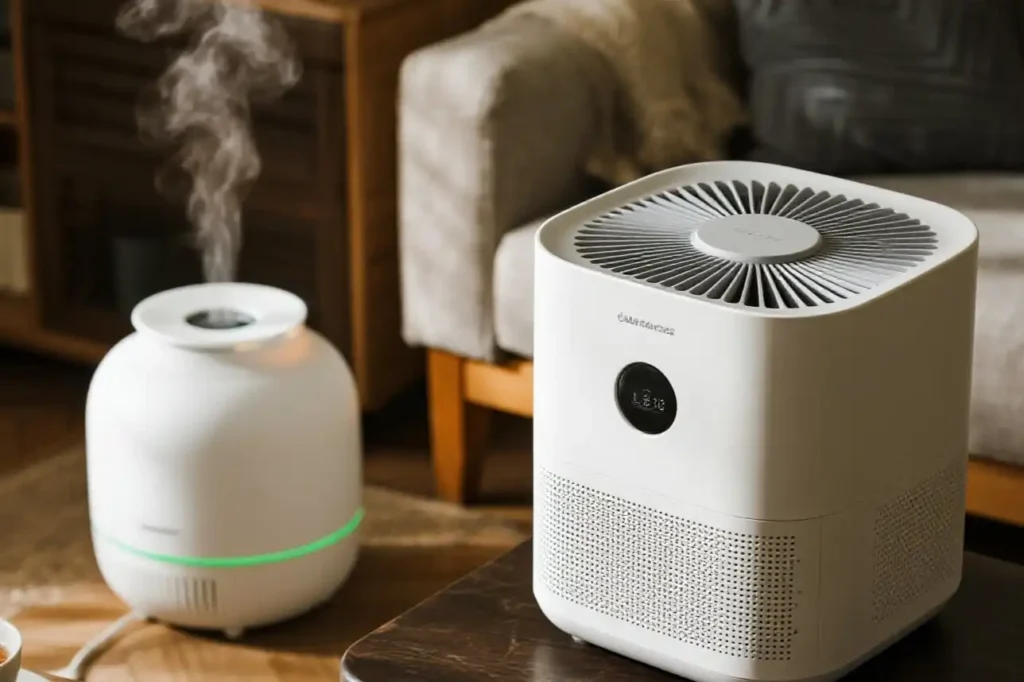
You may ask if it is safe to use humidifiers and air purifiers in the same room. Many people use both to make indoor air better, but there are some things to be careful about. Humidifiers and air purifiers can work well together if you keep them clean and put them far apart. Cleaning both machines often helps stop mold and bacteria from growing. Always check the humidity level with a hygrometer. Try to keep it between 30 and 50 percent. Too much moisture can cause health problems.
Key Takeaways
- Keep humidifiers and air purifiers at least 3 feet apart. This stops filters from getting wet. It also helps both machines work well.
- Use distilled water in your humidifier. This stops minerals from building up. It also prevents white dust. White dust can hurt your health and devices.
- Clean both devices often. This stops mold, bacteria, and dust from growing. It helps keep the air safe.
- Keep indoor humidity between 30% and 50%. This stops mold from growing. It also keeps the air comfy and healthy.
- Pick air purifiers with HEPA filters. Do not use ones that make ozone. Ozone can hurt your lungs.
Using Both Devices

Safety Overview
If you use humidifiers and air purifiers together, your room can be safer and healthier. Most air purifier filters still work well when the air is moist. The water from a humidifier does not hurt the filter. You do not have to worry about the air purifier making the air too dry. Both devices can run at the same time without causing trouble.
Tip: Always clean your humidifier. If you forget, mold and bacteria can grow inside. These germs can get into the air and make you sick. If the humidity goes over 60%, mold and dust mites can grow more. Check the humidity often and keep it under 50%. Pick an air purifier that does not make ozone, because ozone is not safe to breathe.
Make sure your devices are the right size for your room. A small humidifier will not work well in a big room. The same is true for air purifiers. Clean both machines often and change filters to keep them working well and safely.
Combined Benefits
Humidifiers and air purifiers help make the air better together. Humidifiers put water in the air, which helps with dry skin and stuffy noses. Air purifiers take out dust, allergens, and even tiny germs from the air. When you use both, you get more benefits.
- You might cough and sneeze less.
- Your skin and throat may not feel as dry.
- The air can smell and feel cleaner.
Some studies say humidifiers can help stop some viruses from spreading inside. Air purifiers with HEPA filters catch very small things in the air, so it is safer to breathe. Using both can help stop breathing problems and make your home more comfortable. People with allergies or asthma may find it easier to breathe.
Note: Put the devices far apart. This keeps the air purifier filter dry and working well. Check the humidity often and clean both machines to stop mold and bacteria.
Using humidifiers and air purifiers together can make your home healthier and nicer, especially if you have allergies or live where it is dry.
Humidifiers and Air Purifiers: Precautions
Placement Tips
Think about where you put your humidifier and air purifier. If they are too close, the air purifier might suck in wet air. This can make its filter wet and not work well. To stop this, put them on different sides of the room. This helps both machines work better and keeps the filter dry. If you use a combination unit, keep it 2 feet from walls. Also, keep it 4 feet away from electronics or wood furniture. This keeps your things safe from water damage.
Tip: Keep humidifiers and air purifiers at least 3 feet apart. This lets air move well and helps both work their best.
Filter and Maintenance
You need to keep both machines clean to stop problems. Mold, bacteria, and clogged filters can happen if you do not clean them. When you use both together, you may see more dust or white powder. This happens if you use tap water in your humidifier. Mold and bacteria can grow if you do not clean the humidifier often. The air purifier’s filter can clog faster if it catches more dust or water.
Here is a table that shows common problems and how to fix them:
| Device | Common Maintenance Issues | Causes and Notes |
|---|---|---|
| Humidifier | Mold growth, bacteria growth | Not cleaning often, using tap water, or letting water sit too long |
| Mineral dust (white dust) | Using tap water instead of distilled water | |
| Mold spread due to placement | Placing humidifier too close to air purifier causes condensation and mold spread | |
| Air Purifier | Clogged filters (pre-filters, HEPA, carbon) | Filters trap particles and can clog, especially if exposed to moisture from humidifier |
| Reduced airflow and efficiency | Dirty or clogged filters and vents |
Maintenance Checklist:
- Clean the humidifier tank every week with vinegar.
- Change the water in the humidifier every day.
- Use distilled water to stop mineral buildup.
- Replace humidifier wicks every 1-3 months.
- Clean or vacuum air purifier pre-filters every 2-4 weeks.
- Replace HEPA filters every 6-12 months and carbon filters every 3-6 months.
Water Quality
Always use distilled water in your humidifier. Tap water has minerals like calcium and magnesium. These can build up inside and make it work less well. They can also turn into white dust on your furniture and floors. This dust makes cleaning harder and can cause breathing problems. If you use an ultrasonic humidifier, it can send these minerals and germs into the air. This makes the air purifier work harder and can clog its filter.
“Use bottled or distilled water, as tap water in humidifiers can cause mineral and particle buildup to get into the air and cause breathing problems.”
Distilled water keeps your humidifier clean and helps it last longer. It also keeps the air in your room healthier. Health experts and humidifier makers say distilled water is the best choice.
Humidity Monitoring
Watch the humidity level in your room. If the air is too wet, mold and dust mites can grow. Too much humidity can also make the air purifier’s filter damp. This makes it work less well. The best humidity is between 30% and 50%. This keeps the air comfy and safe for your health. You can use a hygrometer to check the humidity. Some humidifiers and air purifiers have sensors or smart apps. These show you the humidity in real time. These features help you keep the right balance.
- Devices with built-in sensors and smart apps help keep humidity safe.
- Some models turn off if the humidity gets too high.
- You can use a simple digital hygrometer to check every day.
Note: If you see water on windows or walls, or if the air feels damp, lower the humidifier setting or turn it off for a while.
Health Warning: If humidity goes above 60%, you risk mold, bacteria, and toxic particles in the air. This can cause breathing problems, especially for kids, older people, and those with asthma.
Ozone-Generating Air Purifiers
Do not use air purifiers that make ozone. Ozone is a gas that can hurt your lungs and make breathing hard. Some air purifiers, called ionizers or ozone generators, let out ozone. Health experts and government groups say not to use these at home. The EPA and California Air Resources Board warn that ozone is dangerous, especially for kids and people with breathing problems. Always pick air purifiers that do not make ozone. Look for models with HEPA filters, which clean the air without making bad gases.
Optimizing Performance

Room Size
Pick devices that match your room size. Each humidifier and air purifier is made for a certain space. If your humidifier is too small, it cannot add enough moisture. A small air purifier will not clean all the air in a big room. Always look at the label to see what size room the device covers.
- Put the air purifier in the middle of the room for best results.
- Keep the humidifier away from the air purifier’s intake so the filter stays dry.
- Make sure nothing blocks the air around either device.
- Check the humidity often and keep it between 45% and 55%.
Tip: Pick devices that match your room’s size. This helps both work well.
Device Scheduling
Run your devices at the right times to get better air. Humidifiers are most useful in fall and winter when the air is dry. Air purifiers help all year, but are extra helpful during allergy season or when the air outside is bad.
- Run your air purifier most of the day if you have allergies.
- Use auto or sleep mode at night to save power and make less noise.
- Change how long you run them based on air quality and room size.
- Keep doors and windows closed when the devices are on.
Smart timers and sensors can help you set the best times to use your devices, like in the morning or evening.
Regular Cleaning
Clean both devices often to keep them safe and working well. Mold, bacteria, and minerals can build up if you do not clean them. Experts say to follow this cleaning schedule:
| Frequency | What to Clean and Do |
|---|---|
| Daily | Empty and refill the humidifier tank, rinse and dry the base and tank, wipe surfaces |
| Weekly | Take apart parts, soak in vinegar or hydrogen peroxide, scrub, rinse, air dry |
| Monthly | Clean heating parts, check seals and vents, check humidity output |
| Seasonal | Deep clean and check as the maker says |
Use white vinegar or mild soap to clean. Always rinse and dry all parts before putting them back together.
Using humidifiers and air purifiers together helps your health. It also makes the air in your room better. Put the devices far from each other. Clean them often so they work well. Always check the humidity in your room. Experts say you should do these things:
- Keep the humidity between 30% and 50%
- Clean both machines often
- Fix any leaks right away
- Open windows when you can
- Make sure air vents are not blocked
- Dust every week with a microfiber cloth
- Look for damage in your insulation
Doing these things will help keep your home safe and fresh.
FAQ
What happens if you place a humidifier too close to an air purifier?
If you put a humidifier near an air purifier, the filter can get wet. This makes the air purifier not work as well. Mold or bacteria might start to grow on the filter. Always keep them at least 3 feet apart.
What type of water should you use in a humidifier?
Use distilled water in your humidifier. Tap water has minerals that can make white dust and block the machine. Distilled water keeps your humidifier clean and helps you breathe better air.
What is the best humidity level for a room with both devices?
The best humidity for your room is between 30% and 50%. This range helps stop mold, dust mites, and bacteria from growing. Use a hygrometer to check the humidity and change your humidifier if needed.
What should you do if you notice white dust around your humidifier?
White dust means minerals from tap water are in the air.
Switch to distilled water to stop the dust. Clean your humidifier often to get rid of any buildup.
What air purifier should you avoid when using a humidifier?
Do not use air purifiers that make ozone. Ozone can hurt your lungs and make it hard to breathe. Pick a purifier with a HEPA filter for safe and good air cleaning.
See also
How humidifiers affect the operation of air purifiers
Using Air Quality Index Sensors for Smarter Air Purification
What Separates Air Purifiers from Air Filters for Home Air Quality
